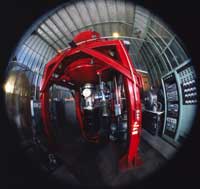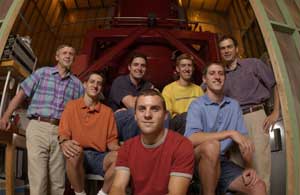Ion Propulsion - 37 Years of Innovation
 |
It worked for more than 16,000 hours. It changed its speed by 7900 miles per hour. It used only 81kg of fuel in two years. It achieved a 61% total efficiency. It only weighed 18.4 pounds. It was the ion engine that propelled the Deep Space 1 spacecraft. And that was over 8 years ago.
For 37 years, Dr. Paul Wilbur, head of ion research at Colorado State University, and CSU students have been working on ion thruster technology. Dr. Wilbur was directly and indirectly involved in the Deep Space 1 mission, and because of him and his students, DS1 has been seen as ion propulsion's greatest achievement.
But DS1 wasn't the first. After successful space testing of ion engines on SERT I and II spacecraft in the 1970s, Robert Beattie, who earned his doctoral degree at CSU in 1976, designed ion thrusters for the Hughes Galaxy G81, the first commercial spacecraft with ion thrusters. Since then, ion propulsion has become standard issue for Boeing 702 space vehicles.
Ion propulsion is planned for even more missions. In the summer of 2007, NASA and the Jet Propulsion Laboratory will launch the newest mission, Dawn. The head of Dawn's ion propulsion systems, John Brophy, earned both his graduate and doctorate degrees at CSU. Utilizing three 30cm diameter ion thrusters, Dawn will study two distinct protoplanets. The low fuel use of the ion thrusters are what allow for Dawn to make a journey to two separate celestial bodies in a single mission.
The idea of ion propulsion is relatively simple. Ions, produced from Xenon gas, are accelerated in an electrical field. After passing through sets of hole pairs in two closely spaced metal plates, the ion crosses through an electron cloud to ensure the ion escapes into space. The result: an opposition force creating a low-thrust form of propulsion.
Ion propulsion enjoys several advantages over more traditional chemical propulsion systems. The ion engine systems weigh significantly less than chemical equivalents. Ion thrusters require considerably less propellant while generating greater velocity changes, and the physical engines themselves weigh less than combustion types. This weight savings allows for more equipment in a satellite or the use of smaller, less costly launch vehicles.
The true use of ion propulsion technology can best be seen in an example from the NASA Ion Propulsion System (NSTAR) DS1 Technology Validation Report. The report states that a spacecraft utilizing ion propulsion is able to travel to the comet 46P/Wirtanen, collect samples, and return to Earth two years earlier than a chemically-propelled spacecraft could make its one way trip to the same comet. And a lack of fuel prevents the chemically-powered rocket from ever being able to return from its mission, limiting the knowledge that could be gained.
But Dr. Wilbur, NASA's Lewis space research grant recipient for over 35 years, is quick to point out that ion propulsion is not a cure-all for space travel. The low thrust provided by the ion engines makes using the technology for many manned missions less likely, due to the extended acceleration time for equivalent velocities.
In addition, the electric field created between the two plates requires precise composition, manufacture, and placement for the engine to work properly. Furthermore, because ion engine power is directly related to its plate area, preventing arcing between the plates becomes increasingly difficult as the engine becomes larger. Arcing is when an electrical discharge, a spark, occurs between the two plates. It is a destructive phenomena which can render an ion thruster useless.
Some of these characteristics are inherent at the root level of the technology, such as low specific thrust, but others can be overcome, and Dr. Wilbur and his team are working on just that. They are joined by Dr. John Williams, a new assistant professor of mechanical engineering, who earned his doctorate under Dr. Wilbur.
The development of solid state ionic conductors has opened up the possibility of supplying ions for propulsion from an appropriately shaped ion-producing, ceramic membrane. Ion thrusters based on this technology have the potential to be even more efficient, more reliable, and more durable than existing technologies. These advances will allow for more expansive missions in the future.
Thousands of man hours have been devoted to developing this technology. Through the work of Dr. Wilbur and his students, important innovations continue to develop. While many of the early ion propulsion researchers were primarily experimentalists, changing variables and simply observing results, the CSU team has been involved both with the conduct of experiments and modeling phenomena associated with ion propulsion. Simply monitoring results from variable manipulation cannot provide all of the tools necessary to advance this technology to its full potential. By creating ways to accurately model multiple areas of ion technology, a fuller scope of engineering can occur. Understanding about ion production, confinement, neutralization, and the process of ion acceleration exists due to the work of CSU faculty and students.
Computer models of phenomena are powerful analytical tools, but real-world data is needed to create and check these phenomena, and this need leads to the creation of new tools. The creation of the Multi-Axis Plasma Profiling System (MAPPS) by Robert Milllot, Casey Farnell, Molly Schmidt, Kyle Siler-Evans, and Dustin Warner, a CSU senior design group, and Dr. Williams, is a result of this drive. The MAPPS device enables the rapid measurement of the current density in an ion beam in three dimensions. Utilizing radial, angular, and axial movement capability and a Faraday probe, the MAPPS apparatus can obtain measurements for various user-defined conditions automatically.
Because of the hands-off nature of MAPPS, in-depth accurate data can be collected quickly, so data of previous tests can be analyzed as new experiments are running. With the data obtained from the MAPPS system, engineers can better understand the ion thruster phenomena, which can lead to better analytical tools. And models like these have allowed ion propulsion technology to reach new levels, and new realms of use.
Even within the earth's atmosphere ion propulsion technology is finding its place. The ability to direct and control ions has found its way into materials science. Ion propulsion technology now allows for more diverse and precise surface engineering of a variety of materials. By precision imbedding of a known number of atoms onto the exterior of a material, engineers can change many of the surface properties of a material. Furthermore, this surface engineering has very little effect on the other physical properties of the bulk material. Friction, corrosion, wear, and oxidation are some of the phenomena that are altered using ion surface engineering. Ion technology even helps make sharper scalpels, which can reduce scars and post-operative time. This new scope of material property management allows for a vast number of new applications for the same material.
From exploring the deepest regions of space to reducing the friction of a knee replacement, ion propulsion technology is an emerging field of engineering. The full potential of ion propulsion has yet to be tapped, and the students and faculty of Colorado State University are at the tip of the spear charging into the future of this exciting new technology.
 |
To learn more about the DAWN mission please visit http://today.colostate.edu/index.asp?url=display_story&story_id=1002289
Story by CSU Alumnus Mark Deacon